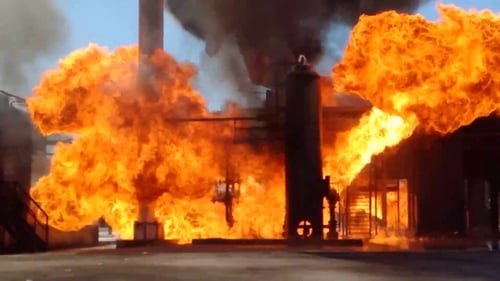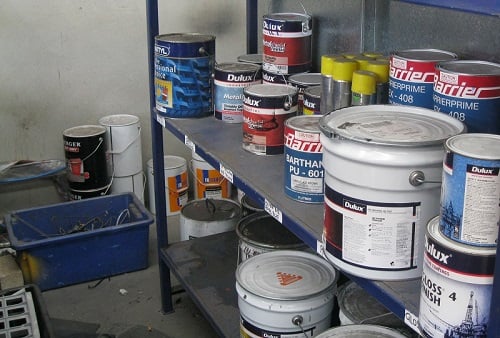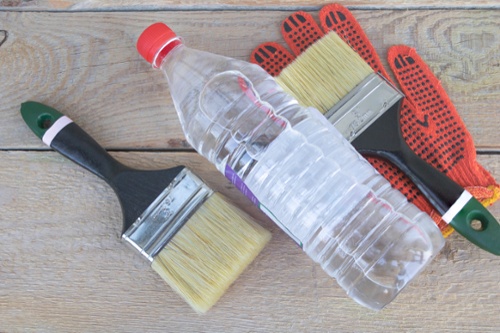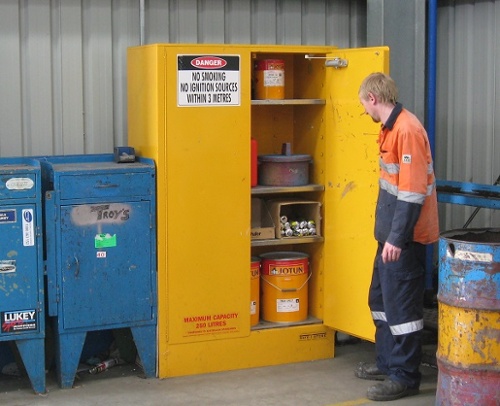Regardless of what industry you’re in or where your business is located, you’ve probably had something to do with dangerous goods or hazardous substances during your working life. You also may not fully understand the difference between dangerous goods and hazardous substances — or you might think that these terms mean the same thing. However, the definition and application of dangerous goods and hazardous substances have significant differences which can dictate how they are stored and handled in the workplace. In this post, we’ll be defining dangerous goods and hazardous chemicals, and explaining what you can do to reduce their risks within your own organisation.
What are Dangerous Goods?
Dangerous goods can be defined as the following:
‘An object, substance or material that presents an immediate degree of risk to people, property and the environment due to the nature of its physical and chemical properties.’
Put simply, dangerous goods present an immediate level of chemical and physical danger to the surrounding environment, including people and property.

Some dangerous goods may cause fires, flashbacks and explosions if they’re not stored or handled in the correct way.
We should all be familiar with the nine classes of dangerous goods: explosives, gases, flammable liquids, flammable solids, oxidizing agents and organic peroxides, toxic substances, radioactive material, corrosive substances, and miscellaneous dangerous goods.
All these classes of dangerous goods present a certain level of danger — in a chemical and/or physical form — to people, property and the environment. For example, some of the dangers include:
- Class 1 Explosives present the obvious danger of an unintended explosion in an uncontrolled, unprepared environment.
- Class 2 Dangerous Gases present the immediate risk of violent chemical reactions if mixed with other incompatible substances and fires from the ignition of flammable vapours.
- Class 3 Flammable Liquids are the most well-known class of dangerous goods. They’re recognised for releasing flammable vapours capable of ignition, when held at temperatures above the substances’ flash point. Note that the flashpoint of most flammable liquids are equal to or below standard working temperatures.
- Class 4 Flammable Solids –present various risks such as spontaneous combustion and the emission of flammable gases when in contact with water.
Each class of dangerous goods presents a different risk — but each risk has the potential to harm people, property and the environment.
Dangerous goods can include everyday products such as paints, chemicals, oil, diesel, petrol and many other commonly used substances.

Commonly found items can also be classed as dangerous goods, so it’s important to read the Safety Data Sheet of each product to ensure safe handling and storage.
When dangerous goods are used in the workplace, staff must be aware of their dangerous properties so they can be stored in a safe and compliant manner. The properties of dangerous substances can be found by checking the product’s SDS, as well as speaking to a product supplier, or consulting with a dangerous goods specialist.
IMPORTANT: Standards Australia has established a set of standards relevant to the different classes of dangerous goods. These Australian Standards detail the handling and storage requirements for each particular class of goods so organisations can reduce the risk that these goods pose.
What Are Hazardous Substances?
Hazardous substances can be defined as:
‘A product, material or substance that has the potential to be harmful to a person’s health, both short and long term.’
In short, hazardous substances are substances that are dangerous to a person’s health.
Each state has its own legislative requirements regarding hazardous substances, generally in the form of a code of practice that supports a regulation and the occupational health and safety acts. Despite some codes of practice being voluntary and not enforceable by law, there are other codes of practice which are supported by regulations and acts which make them mandatory.

Hazardous chemicals pose a risk to human health and need strict handling and storage procedures to reduce potential exposure.
It’s important to speak with a specialist to ensure that you are meeting regulatory compliance in regards to the handling and storage of hazardous substances.
The most common hazardous substances are toxics, corrosives and irritants. This includes substances such as asbestos, acids, pesticides and heavy metals.
Difference Between Dangerous and Hazardous Substances
Are you searching for an answer to, ‘What’s the difference between HAZMAT and dangerous goods?’ The core difference that lies between dangerous goods and hazardous substances is that dangerous goods present an immediate danger to people, property and the environment, that may ultimately harm a person’s health.
On the other hand, hazardous substances are substances that present a direct risk to a person’s health through short- or long-term exposure. Hazardous substances are dangerous, particularly if the exposure to the hazardous substance is an extended period. Conditions such as breathing issues and cancer can result from the long-term exposure to hazardous substances.
However, dangerous goods present a more immediate risk — and need to be constantly controlled as a direct danger.
Should a worker come into contact with a hazardous substance for a short period of time, they are not as likely to be presented with the same level of risk that they would be when exposed to a substance classed as a dangerous good.
Let’s take asbestos (hazardous substance) and acetone (Class 3 Dangerous Good) as examples:
People that have suffered health effects from products such as asbestos have generally been exposed to the substance for a significant period.
If someone was near a flammable liquid, such as acetone, for a short amount of time and the substance came into contact with an ignition source, the substance would ignite and put that person at an immediate risk of severe harm.

Flammable liquids, such as acetone, can ignite if ignition sources are not correctly identified and removed from the workplace.
Evidently, there is some overlap between dangerous goods and hazardous substances. No matter whether the substances that are used in your workplace are classified as a dangerous good or a hazardous substance, it is important to implement the necessary controls to reduce the risks that they have upon the people, property and environment of your organisation.
How to Reduce the Risk of Dangerous Goods and Hazardous Substances
Despite the overlap between dangerous goods and hazardous substances, both categories need to be controlled according to their unique properties to ensure that the risks they present upon the workplace are reduced.
In the next section of our post, we’ll outline some factors that can be considered in regard to the storage and handling of both dangerous goods and hazardous substances.
Know Your Chemical Products
Firstly, it is crucial that you are familiar with the products that you are handling and storing. You may be aware of the substance’s risks and dangers, but what about everyone else that could be potentially exposed to the substance?
Everyone in the workplace must be familiar with the hazardous properties associated with the substance that they are exposed to.
Install and Maintain Correct Storage
It is important to ensure that you store all dangerous goods and hazardous substances in a safe can compliant manner. All dangerous goods and hazardous substances present different risks and therefore they must all be stored using different methods.

Your storage will be determined by the properties and risks associated with each of your hazardous substances or dangerous goods.
If you are unaware of how each substance must be stored, it’s crucial that you consult with a dangerous goods expert.
Signage and Labelling
Dangerous goods and hazardous substances must be signed and labelled to make people aware of the potential risks associated with the substances.
You must also have the correct documentation, such as Safety Data Sheets (SDS), to allow workers look up information, including best practices for the storage and handling of each substance.
Your SDS should be located in a document holder, located in an easily accessible, highly visible location. This is so staff (or emergency services) can gain instant access to these essential chemical documents, when they are required

For the safety of your staff and your organisation, you must ensure your SDS are readily available, with handling and storage guidelines strictly followed.
Over time, dangerous goods and hazardous substances will slowly degrade your storage facilities. To ensure that your workplace is adequately protected, it’s vital that you have scheduled maintenance programmes to keep your dangerous goods storage facilities in good condition. By properly maintaining your controls, you can protect the people in your workplace from the risk associated with substances stored within.
Understanding Your Dangerous Goods
We hope you’ve gained a better understanding of the difference between HAZMAT and dangerous goods. As dangerous goods and hazardous substances present many risks upon the people and property in your workplace, it’s important that you implement the necessary controls to reduce the harm that they could have upon the people in your workplace. To successfully implement preventative controls, you must first be aware of properties associated with the 9 different classes of dangerous goods.
Would you like more information on the chemical and physical properties of the 9 Different Classes Of Dangerous Goods? Our guide contains helpful information in an easy-to-understand format, so you can create a safer environment in your own business. Access your eBook for free today to learn more about dangerous goods.
Joining the team as a Dangerous Goods Storage Consultant, Melissa Hampton became Storemasta's Marketing Manager in late 2021. With extensive knowledge and experience in chemical compliance, Melissa is responsible for leading the Marketing team and helping shape their marketing strategy. In her spare time, you can find Melissa hiking, swimming and enjoying the great outdoors in beautiful north-west Tasmania.
